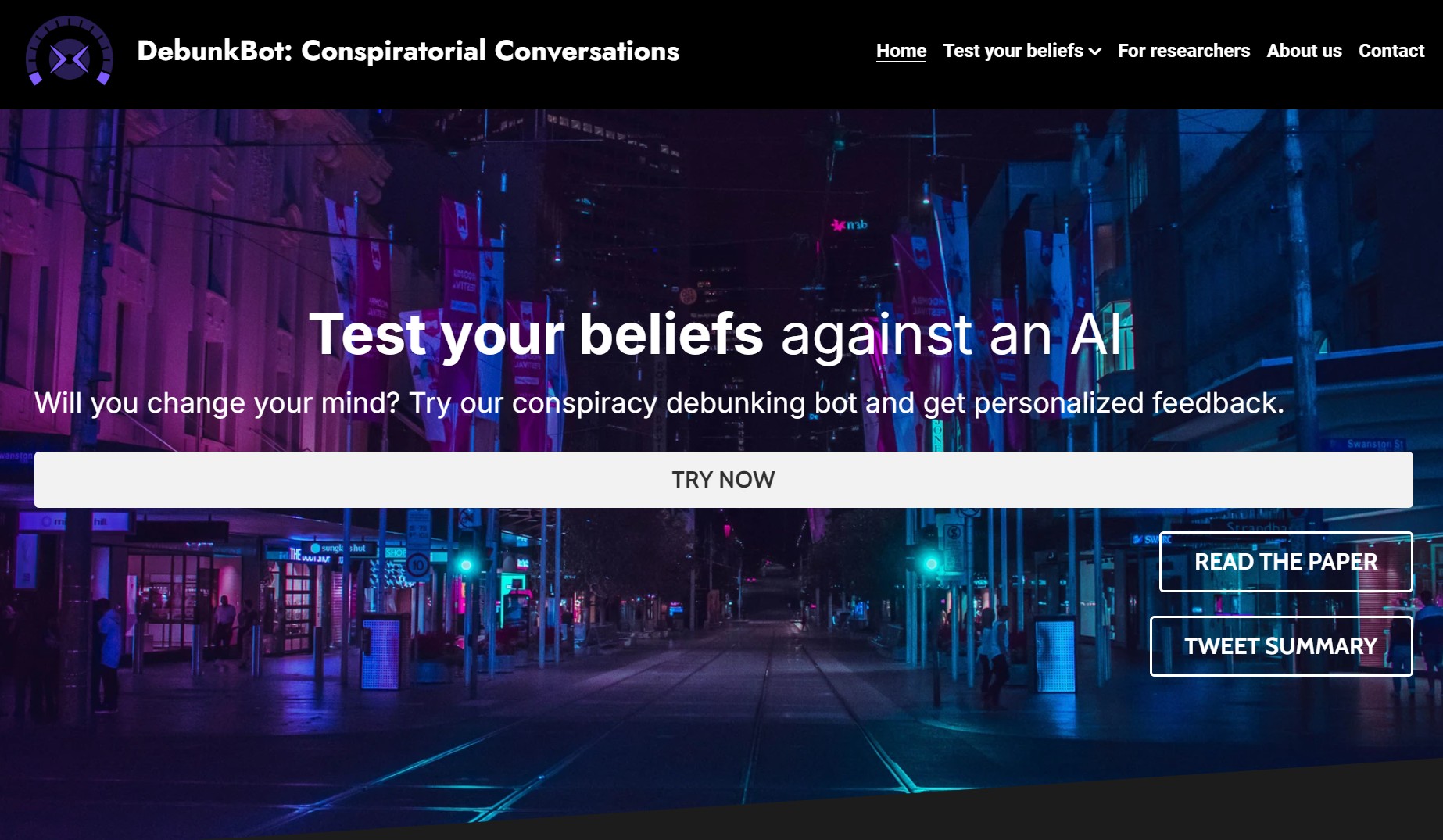DebunkBot: Teaching With The Conspiracy-Busting AI
Created by researchers at MIT and other higher ed institutions, DebunkBot engages in conversation with users about conspiracy theories. It’s an interesting tool for teaching AI and media literacy.

Education and the world have been overrun with AI tools. Trying to keep pace with it all as a journalist and educator has become a challenge for me, and I’m sure for many others. Some of these tools blur together and seem to do more or less the same thing. ChatGPT is similar to Google's Bard (or is Gemini now?). Is the popup offering to write my email an AI tool from Grammarly or Apple?
I bring all this up because DebunkBot is distinctly different from any other AI tool I’ve come across. Created by academics at MIT, Cornell, and American University, and unveiled in what still feels like its beta form, DebunkBot is designed to help “debunk” conspiracy theories.
I teach writing and journalism. So like many, I bemoan the rise of social media-fueled fake news and the subsequent habit of public figures labeling any facts they disagree with as such.
I recently spent some time exploring DebunkBot. I plan on sharing it with students and think the tool, even with its limitations, could be an engaging class exercise for journalism, history, and/or media literacy lessons, though its use is restricted to those 18 and older.
Here’s a closer look at what I found.
DebunkBot: What Works Really Well
Having nothing to do with the content, I love the privacy options DebunkBot offers users. Before using the tool, you’re asked if you will consent to allow data from your session to be analyzed by the team. You can decline and still use DebunkBot, and even if you accept, a warning comes up reminding you not to disclose any personal-identifying information. This is important and so often overlooked when using a tool with students.
During my sessions with DebunkBot, I asked it to refute a number of conspiracy theories. It quickly provided me with evidence of why these various theories — which ranged from U.S. having foreknowledge of the Pearl Harbor attack to alien sightings covered up by the U.S. government — were likely not true. In that way, it functions as a kind of on-demand Snopes/fact-checking tool. But it goes further than that by engaging in dialogue around these ideas, attempting to explain in more detail and addressing additional questions.
Tools and ideas to transform education. Sign up below.
DebunkBot has a nice nonjudgmental tone, and I like that it applauds question-asking in general and provides real documentation. For instance, in response to my UFO-related questions about the 1947 Roswell incident involving the alleged crash of a UFO, it pointed to the Project Blue Book investigations by the U.S. government as evidence against UFOs and correctly pointed out that UAP (unidentified aerial phenomenon) is the preferred term these days -- I just still prefer the old school terminology.
Crucially, the chatbot didn’t criticize the curiosity behind the question. “The fascination with UAPs and the possibility of alien life forms can coexist with a healthy skepticism and a reliance on scientific inquiry to seek explanations grounded in evidence that we can all examine,” DebunkBot wrote. I couldn't agree more.
Limitations of DebunkBot
Right now the tool is being made available to the public as part of a research survey for MIT. That makes using it a little cumbersome. You have to answer several questions before DebunkBot starts discussing a given conspiracy theory with you. This is not a problem if you’re using it as a one-time exercise, but makes everyday use somewhat impractical.
DebunkBot also tries to get people to question their conspiracy theories through dialogue. I love that idea but the pessimist in me has found that most conspiracy theorists find one strange thing that happened and then discount any and all evidence that contradicts their perception. Therefore, I’m not sure engaging in dialogue will be helpful. So even though I think this a fun teaching tool, I'm not sure I would recommend it to someone in order to change their beliefs about a given conspiracy.
Would I Use DebunkBot In Class?
Yes, despite the minimal limitations mentioned in the previous section, I enjoyed experimenting with DebunkBot. I plan on sharing it with students in a future class exercise.
In addition to discussing specific theories and mysteries, I think it’s a good tool for media literacy and AI literacy. What bias is the AI falling prey to in its answers? What parts of the conversation are being left out, etc.? These are questions that students can explore in a more interactive way thanks to this unusual AI platform.
Part of the job of teaching journalism is helping students learn how to balance healthy suspicion of official reports, actions, narratives, etc., without falling down a “we’re all puppets without strings” rabbit hole. DebunkBot seems to understand this and is well-suited to helping students find this balance. Unlike other AI Chatbots, it's not obviously controlled by lizard people trying to take over the world and unnecessarily eliminate salt from our diets -- wait, maybe I need to spend more time with DebunkBot fact-checking what I read on the internet.
Erik Ofgang is a Tech & Learning contributor. A journalist, author and educator, his work has appeared in The New York Times, the Washington Post, the Smithsonian, The Atlantic, and Associated Press. He currently teaches at Western Connecticut State University’s MFA program. While a staff writer at Connecticut Magazine he won a Society of Professional Journalism Award for his education reporting. He is interested in how humans learn and how technology can make that more effective.

